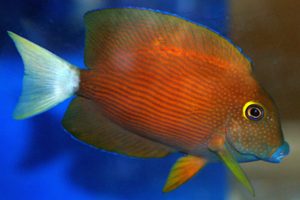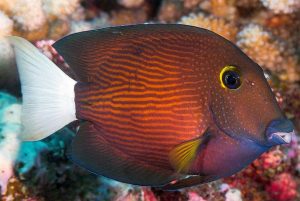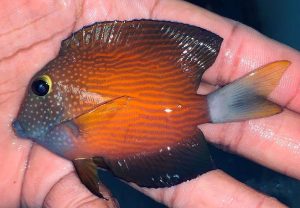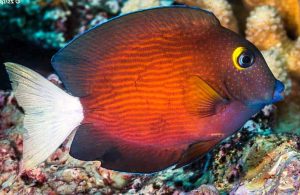The White Tail Bristletooth Tang (Ctenochaetus flavicauda) known to tropical fish keeping enthusiasts as the White Tail Yellow Eye Tang or White Tail Yellow Eye Kole Tang is found in the U.S. Minor Islands in the Western Pacific; to the Austral, Line, Rapa, and Society Islands in the East Central Pacific Ocean.
White Tail Bristletooth Tangs are found singly and in small groups of 6 to 12 individuals among areas of dense coral growth on the shallow coral reefs, sheltered coastal lagoons, and coral slope dropoffs at depths from 3 to over 90 feet where they graze on algae, seaweed, and zooplankton.
White Tail Bristletooth Tangs spend the majority of their day grazing among the rocks and coral mantels in the densely populated coral reefs and flats of their range where food is most abundant and protection is available to them from other larger predatory reef species.
Ctenochaetus Tangs have a protruding mouth with bristle like teeth that they can move individually to sift, sort, and scrape rocks and substrate in search of food. The White Tail Bristletooth Tang is the smallest acanthurid and the smallest ctenochaetus tang, growing to only about 5 inches in length. It is an excellent rock cleaner and will take care of many different types of nuisance algae found in your aquarium.
At first glance the White Tail Bristletooth Tang looks like a Kole Tang (Ctenochaetus strigosus) however, the Kole tang is a native of Hawaii while the Whitetail tang frequents the west Pacific.
Adult White Tail Bristletooth Tangs have a beautifully deep reddish brown body with orange spots on its head that stream into the fine, orange colored horizontal body striping along the body, a sharply contrasting distinctive bright show white tail, and small bright yellow circles around the eyes.
Juvenile Ctenochaetus flavicauda and Ctenochaetus strigosus are a bright yellow color, but only
Ctenochaetus flavicauda take on the reddish maroon body color and vivid white tail as they mature into adulthood.
The White Tail Bristletooth Tang is best housed in a mature FOWLR or reef tank of at least 75 gallon capacity with a crushed coral or sandy substrate, substantial quantities of mature coral encrusted live rock arranged into crevices, caves, and overhangs for them to graze and hide among, plenty of free swimming space, and a good amount of water movement.
Although the White Tail Bristletooth Tang is normally peaceful towards most tank mates and will not bother sessile invertebrates or corals, they can become seriously aggressive towards other Tangs; especially those in the Ctenochaetus family or fish they perceive as competition for food.
Tropical fish keeping enthusiasts intending to keep this species with other tangs should house them in an aquarium of at least 125 gallon capacity with plenty of swimming area and mature live rock, and stock it with at least 6 or more tangs to spread out aggression between species. To farther reduce aggression between the tangs, try to introduce all of them into the tank at the same time and provide plenty of algae for them to graze on.
The White Tail Bristletooth Tang has not been bred in an aquarium environment. Like other members of the surgeonfish family, they are egg scatters that broadcast their spawn in groups. Sexing is difficult but if you plan to keep a breeding harem of White Tail Bristletooth Tangs, you will need at least 6 to 10 individuals at a minimum in an appropriately sized aquarium to develop a pair.
The White Tail Bristletooth Tang needs a steady diet of marine based algae and seaweed to maintain their immune systems and remain healthy.
In an aquarium environment they are excellent rock cleaners and will consume several different types of nuisance algae that may be in your tank. They should also be offered a varied diet of meaty foods, flakes, and frozen foods. The majority of their diet in an aquarium with sufficient amounts of mature live rock should consist of algae, nori, and herbivore preparations. Dried seaweed (nori), romaine lettuce, and other leafy lettuces on a veggie clip
should be presented 2 or 3 times a week or more. They will also accept high quality flake and pellet foods, as well as Mysis and brine shrimp. Sea Veggies, Seaweed Salad, and Seaweed Selects are all ideal products that are easy to use.
The White Tail Bristletooth Tang (Ctenochaetus flavicauda) is an uncommon and somewhat rare species that is not often available to tropical fish keeping enthusiasts. They are a great fish for controlling algae in the saltwater fish or reef aquarium and occasionally available online from specialty fish shops, online wholesalers, retailers, and trans shippers at the following approximate purchase sizes: Small: 1.5″ to 2-1/2″; Medium: 2-1/2″ to 4″; Medium/Large: 4″ to 5″ Large: 5″ to 6″. Prices start at $245.00 for small medium.
Minimum Tank Size: 75 gallons
Aquarium Type: Reef or FOLR
Care Level: Moderate
Temperament: Semi Aggressive
Aquarium Hardiness: Hardy
Water Conditions: 72-78° F, dKH 8-12, pH 8.1-8.4, sg 1.020-1.027
Maximum Size: 4.6″
Color Form: Black, Orange, Red, White
Diet: Herbivore
Compatibility: Reef
Origin: South Pacific, Coral Sea, Fiji, Indo-Pacific, Tahiti
Family: Acanthuridae
Lifespan: 5 to 7 years
Aquarist Experience Level: Intermediate






